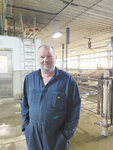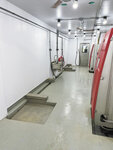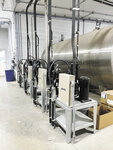


ALEXANDRIA, S.D. — Robotic milking facilities are often purpose-built, but existing dairy barns can also be successfully converted to accommodate robotic milkers.
A good example of this can be seen at Oak Lane Hutterite Colony, located in rural Alexandria.
Joey Wipf is the dairy manager at Oak Lane Colony. The colony is currently milking 310 head of Jersey cows with six Lely robotic milking systems.
“We built our dairy barn in 2009 and milked in a double-16 parallel parlor for the next 14 years,” Wipf said.
That began to change in 2022, when Oak Lane Colony added onto their dairy barn and initiated the process of installing their first set of four robotic milkers.
“We have done all of the construction work on the barn ourselves,” Wipf said. “We did the dirt work and poured the concrete, (and) we have our own plumber and electrician, but before we started to remodel for robots, we consulted with the folks at Gorter’s Clay and Dairy regarding the design. When the robot rooms were ready, the folks at Gorter’s came here and installed the robots and the associated equipment.”
The new addition that was built onto the dairy barn houses a pair of 6,000-gallon milk tanks.
“We decided that it was better to move the tanks closer to the robots than pipe the milk such a long ways,” Wipf said.
A unique feature of the new milk room is a geothermal system to cool the milk. A set of 100-foot-deep boreholes were sunk near the barn, and a loop of plastic tubing was placed inside each borehole. The tubes carry water that is used to extract heat from the milk coolers’ compressors and discharge the heat into the earth.
“We really like the geothermal system,” Wipf said. “The compressors don’t need cooling fans, so there’s no dust or noise. It cost more to install the geothermal system, but we feel that it will be worth it in the long run.”
Oak Lane Colony recently installed two additional robotic milkers, bringing their total up to six robots. Their newest robot room includes spots for two more robotic milkers.
“We are slowly growing our herd from within,” Wipf said. “Our dry cows are currently being housed in the dairy barn. When our milking herd gets big enough, we will move the dry cows to another barn and install the last two robots. We will then have the capability to milk up to 520 head.”
There were very few issues with getting the Jersey cows at Oak Lane Colony to adapt to the robotic milkers.
“The changeover went very smoothly,” Wipf said. “I was told by the folks at Gorter’s that ours was the easiest switch to robots that they had ever seen.”
The dairy herd at Oak Lane Colony has responded well to the new milking system.
“Because the cows are now getting milked three times a day instead of twice a day, we picked up 12 pounds of production right away,” Wipf said. “We are now averaging 65 pounds per head per day with 5.2% butterfat and 3.9% protein.”
But the cows weren’t the only ones to reap the benefits of robots.
“I don’t have to be in the barn at 4:00 a.m. anymore,” Wipf said. “I can get here at 8:00 a.m. instead. The robots have helped us save on labor. Plus, it’s nice to not be so tied down. We have very few fetch cows; each pen of 120 cows will have maybe one or two fetch cows each day.”
All of Oak Lane Colony’s cows wear a collar that collects data on daily activity and how much time is spent ruminating.
“We get all sorts of valuable information from the robots,” Wipf said. “If a cow’s rumination time is down, we will take a good look at her and follow our treatment protocols if need be. Sometimes it will simply be that she was in heat.”
The free stall facility at Oak Lane Colony has a flat roof. The barn’s free stalls are equipped with rubber mats that are bedded twice a week with sawdust. The barn is naturally ventilated and features a flush system that sweeps away manure once an hour, 24 hours a day.
“When we built the barn, we constructed a set of 20,000-gallon concrete tanks to hold flush water,” Wipf said. “The flush system is simple, with one air-operated valve in each tank that releases the flush water. We have seen only small amounts of frozen flush water during the coldest winters. The cows keep the barn pretty warm.”
Wipf has no regrets about making the switch to robotic milkers.
“The cows now have a lower (somatic cell count), and we have seen their overall health improve,” Wipf said. “Our cows have become tamer and seem happier. All of those things makes make us happy.”
Oak Lane Hutterite Colony will be hosting an open house in their dairy facility on Wednesday, June 26.
Comments
No comments on this item Please log in to comment by clicking here